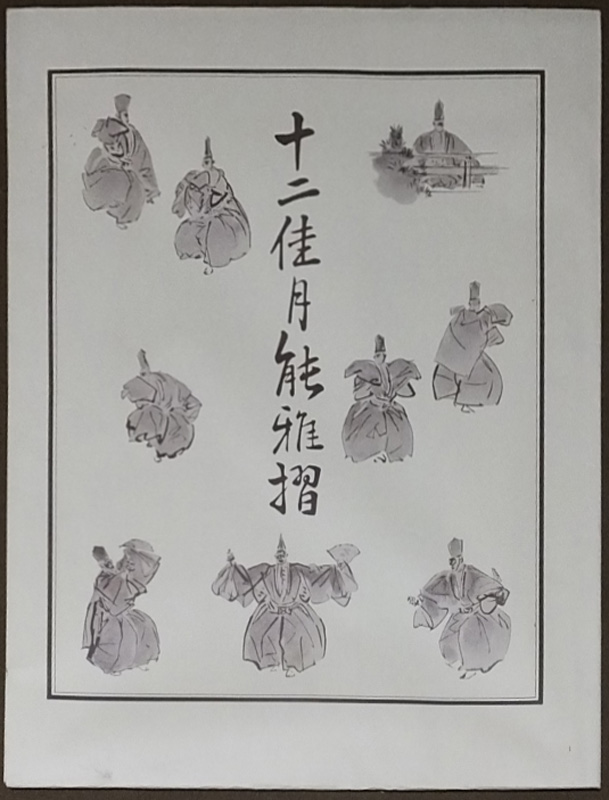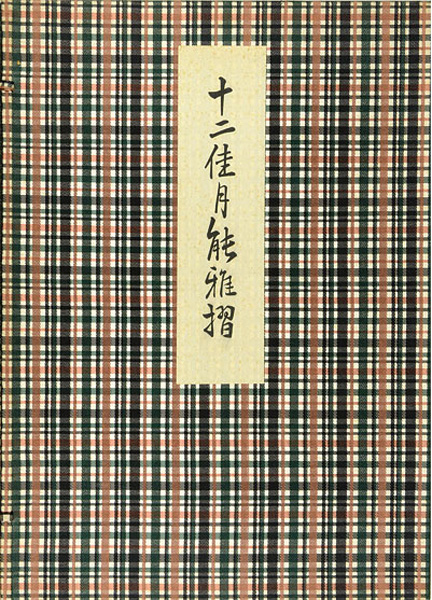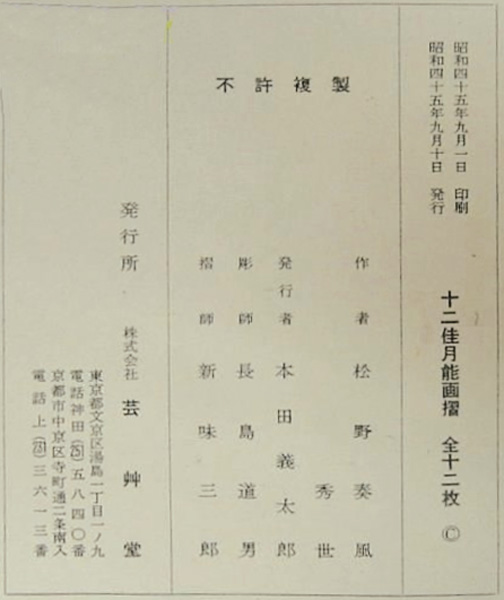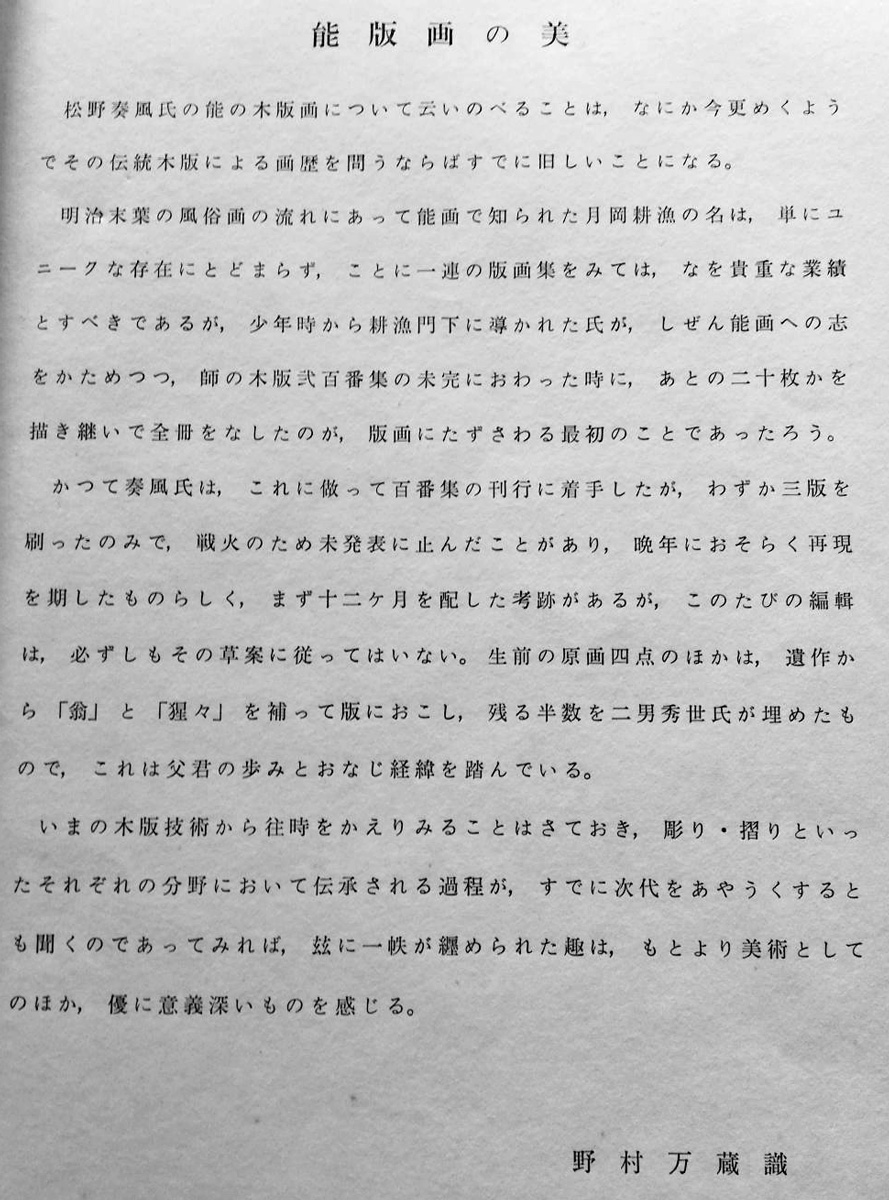About This Print and Twelve Months of Noh Pictures
This print depicts the dance of a young woman as she insinuates herself into the Dōjōji temple. She will shortly undergo a transition to a serpent.
Twelve Months of Noh Pictures
From a series of twelve prints depicting twelve Noh plays, one play for each month, published by Unsōdō Publishing in 1970. Six of the prints (for the months of January, February, June, September, November and December) were created by Matsuno Sōfū (1899-1963) and the other six (for the months of March, April, May, July, August and October) were created by his son Matsuno Hideyo (1936-2002). As Sōfū died in 1963, his prints must have been created from existing designs.
As originally issued, the prints were sold as a set with each print placed inside its own mat, which was overlayed with a commentary sheet on the play, written by Matsuno Hideyo, in Japanese and English. The matted print and commentary were then placed inside an envelope (shown below, left) and all twelve envelopes were then placed into a cloth folio (shown below, right). Also included was a one page introduction (reproduced below), written by the kyōgen star, mask carver and author Nomura Manzō 野村万蔵 (1898-1978), who was named a Living National Treasure in 1967.
The artist seals appearing on the prints, each one being different, are translated into English on the commentary sheet for each print and seem to relate to the play being pictured.
colophonRight Column:昭和四十五年九月一日 [ Printing date: September 1, 1970]昭和四十五年九月十日 [Publishing date: September 10, 1970]十二佳月能雅摺 全十二枚 [Twelve Months of Noh Pictures. Complete set of 12 prints]
Center Column:
不許複製 [All rights reserved]作者 松野奏風 秀世 [authors Matsuno Sōfū (and) Hideyo]発行者 本田義太郎 [publisher Honda Gitarō (reading of name uncertain]彫師 長島道男 [carver Nagashima Mishio]摺師 新味三郎 [printer Shinmi Saburō]
Left Column:
発行所 株式会社 芸艸堂 [Publishing House Unsōdō Corporation]
[address, etc.]
The Play - Dōjōji (akagashira)
Akagashira style is a special variation that places even greater demands on the actor. Akagashira or "red wig" also references a particular red wig worn in the production.
Source: A Guide to No, P.G. O'Neill, Hinoki Shoten, 1929, p. 21-22.
Fourth Group
All schools
Characters:
Akagashira style is a special variation that places even greater demands on the actor. Akagashira or "red wig" also references a particular red wig worn in the production.
Source: A Guide to No, P.G. O'Neill, Hinoki Shoten, 1929, p. 21-22.
Fourth Group
All schools
All schools
Characters:
Act 1: Waki - a priest of the DōjōjiWaki-tsure - two attendant priestsKyōgen - two servantsShite - a dancer
Act 2:Nochi-shite - a serpent
On the day of a ceremony held in the Dōjō-ji temple to celebrate the installation of a new bell, a woman dancer comes there. Although women are forbidden to enter the compound, she persuades a servant to let her in by saying that she wants to perform a dance in honour of the occasion. She dances and then seizes the opportunity to move beneath the bell and pull it down on top of her. The noise of the falling bell throws the servants into great alarm, and when the priests are told what has happened, one of the realises who the woman is. When a young yamabushi priest went on his yearly pilgrimage to Kumano, he explains, he used to stay in the house of an old man who lived with his daughter. In joke, the old man told her that the priest was to be her husband, and the girl grew up believing this. When, eventually, the priest refused her, she followed him to the Dōjō-ji where he had been hidden under the bell. Having changed into a serpent on the way to cross a river in her pursuit, she coiled herself round the bell and took her revenge on the priest by reducing it to a flaming, molten mass. Convinced that it is this woman who has returned, the priests approach the bell rubbing their rosaries and murmuring prayers. The bell is lifted and reveals the serpent, but this time the priests drive it away into the river by means of their holy power.
Source: Japanese No Plays, Tourist Library Vol. 16,Zemmaro Toki, Japan Travel Bureau, 1954, p. 170.This is one of the most popular of the Noh plays, but as may be expected, it is also technically one of the most difficult to perform. Consequently, its performance involves a skill which many a Noh actor guards jealously as the secret of the art into which only the best disciples may be initiated. What is particularly noteworthy in this play is the clever transition from the graceful to the ghostly which the actor is required to portray by his dancing.
Print Details
| IHL Catalog | #1885 |
| Title |  IHL1885 title 200h web.jpg) |
| Series/Album | Twelve Months of Noh Pictures 十二佳月能雅摺 Jūnikagetsu noh ga suri |
| Artist | Matsuno Hideyo (1936-2002) |
| Signature |  IHL1885 sig seal 200h web.jpg) |
| Seal | The commentary accompanying the print states "Characters inscribed in the seal (see above) mean: 'Other Than Cherries, Naught But Pines." |
| Date | Publishing date: September 10, 1970 昭和四十五年九月十日 as printed on colophon Printing date: September 1, 1970 昭和四十五年九月一日 as printed on colophon |
| Edition | first and only |
| Publisher |  IHL1885 pub seal 150h web.jpg) |
| Carver |  IHL1885 carver seal 150h web.jpg) |
| Printer | suri Shinmi 摺 新味  IHL1885 printer seal 150h web.jpg) |
| Impression | excellent |
| Colors | excellent |
| Condition | excellent - several very light spots of foxing lower right of print |
| Genre | nishiki-e; Nōgaku zue [Noh play picture] |
| Miscellaneous | |
| Format | oban |
| H x W Paper | 15 3/16 x 10 9/16 in. (38.6 x 26.8 cm) |
| H x W Image | 14 3/8 x 9 1/2 in. (36.5 x 24.1 cm) |
| Collections This Print | The Ruth Chandler Williamson Gallery, Scripps College 2006.1.49 |
| Reference Literature |
8/30/2018


 IHL1885 web.jpg)




 IHL1885 cover sheet 800x674 web.jpg)